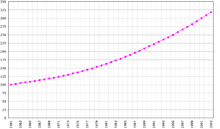- Demographics of the Maldives
-
This article is about the demographic features of the population of the Maldives, including population density, ethnicity, education level, health of the populous, economic status, religious affiliations and other aspects of the population.
Demography
The Maldives had one of the highest birth rates in the world. The result is that many islands have become overpopulated and are completely covered by homesteads. Hence the country is becoming less self-sufficient by the day.
CIA World Factbook demographic statistics
The following demographic statistics are from the CIA World Factbook, unless otherwise indicated.
Population
301,475 (July 2000 est.) - 369,031 (July 2007 est.) [1]
Age structure
- 0-14 years: 22.3% (male 45,038/female 43,291)
- 15-64 years: 73.8% (male 180,874/female 111,703)
- 65 years and over: 3.9% (male 7,711/female 7,717) (2010 est.)
Population growth rate
-0.168 (2010 est.)
Birth rate
38.96 births/1,000 population (2000 est.) - 34.2 births/1,000 population (2007 est.) - 14.55 births/1,000 population (2010 est.)
Death rate
8.32 deaths/1,000 population (2000 est.) - 6.88 deaths/1,000 population (2007 est.) - 3.65 deaths/1,000 population (2010 est.)
Net migration rate
-12.58 migrant(s)/1,000 population (2010 est.)
Sex ratio
- at birth: 1.05 male(s)/female
- under 15 years: 1.06 male(s)/female
- 15-64 years: 1.04 male(s)/female
- 65 years and over: 1.09 male(s)/female
- total population: 1.05 male(s)/female (2000 est.)
Infant mortality rate
65.52 deaths/1,000 live births (2000 est.) - 53.25 deaths/1,000 live births (2007 est.) - 29.53 deaths/1,000 live births (2010 est.)
Life expectancy at birth
- total population: 62.2 years (2000 est.) - 64.76 years (2007 est.)
- male: 61.05 years (2000 est.) - 63.41 years (2007 est.)
- female: 63.4 years (2000 est.) - 66.19 years (2007 est.)
Total fertility rate
1.83 children born/woman (2010 est.) [2]
Nationality
- noun: Maldivian(s)
- adjective: Maldivian
Ethnic groups
The largest ethnic group are Dhivehis, native to the historic region of the Maldive Islands comprising today's Republic of Maldives and the island of Minicoy in Union territory of Lakshadweep, India. They share the same culture and speak the Dhivehi language. They are principally an Indo-Aryan people, closely related to the Sinhalese having traces of Arab, Malay, South Indian and African genes in the population.
In the past there was also a small population known as the Giraavaru people. This group have now been almost completely absorbed into the larger Maldivian society but were once native to the island of Giraavaru (Kaafu Atoll).
Religions
Originally the Maldivians were Buddhists who converted to Sunni Islam in the mid-12th century. Sunni Islam is now the only accepted religion, though there are small numbers of others, particularly Buddhists workers from Sri Lanka and Hindus from India. Also 300 Christians.
Languages
Dhivehi or Maldivian, a language closely related to Sinhala and written in a specialized Arabic script (Tāna), is the official language and is spoken by virtually the whole population. English is also spoken as a second language by many.
Literacy
- definition: age 15 and over can read and write
- total population: 96.3%
- male: 96.2%
- female: 96.4% (2000 census)
Education
The average Maldivian citizen has 4.7 years of education[1]
References
- ^ Neil Merret (30 November 2010). "Average Maldivian citizen has 4.7 years of education, finds UN Human Development Report". Minivan News. https://www.cia.gov/library/publications/the-world-factbook/geos/mv.html. Retrieved 7 January 2011.
- H.C.P. Bell, The Maldive Islands, An account of the physical features, History, Inhabitants, Productions and Trade. Colombo 1883, ISBN 81-206-1222-1
- Xavier Romero-Frias, The Maldive Islanders, A Study of the Popular Culture of an Ancient Ocean Kingdom. Barcelona 1999, ISBN 84-7254-801-5
Ethnic groups in Asia Sovereign
states- Afghanistan
- Armenia
- Azerbaijan
- Bahrain
- Bangladesh
- Bhutan
- Brunei
- Burma (Myanmar)
- Cambodia
- People's Republic of China
- Cyprus
- East Timor (Timor-Leste)
- Egypt
- Georgia
- India
- Indonesia
- Iran
- Iraq
- Israel
- Japan
- Jordan
- Kazakhstan
- North Korea
- South Korea
- Kuwait
- Kyrgyzstan
- Laos
- Lebanon
- Malaysia
- Maldives
- Mongolia
- Nepal
- Oman
- Pakistan
- Philippines
- Qatar
- Russia
- Saudi Arabia
- Singapore
- Sri Lanka
- Syria
- Tajikistan
- Thailand
- Turkey
- Turkmenistan
- United Arab Emirates
- Uzbekistan
- Vietnam
- Yemen
States with limited
recognition- Abkhazia
- Nagorno-Karabakh
- Northern Cyprus
- Palestine
- Republic of China (Taiwan)
- South Ossetia
Dependencies and
other territories- Christmas Island
- Cocos (Keeling) Islands
- Hong Kong
- Macau
Categories:- Maldivian society
- Demographics by country
Wikimedia Foundation. 2010.

